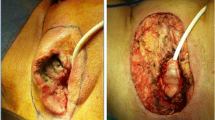Abstract
Background
The extralevator abdominoperineal excision (ELAPE) procedure creates an extensive soft tissue defect of the pelvic floor. It has been suggested that primary reconstruction reduces the risk of wound infection and delayed wound healing in this high-risk area. Use of myocutaneous flaps or omentoplasty are associated with functional limitations and complications. We performed the perineal variant of the lotus petal flap, which was originally described for vulvar reconstruction. We aimed to verify if application of the lotus petal flap in pelvic floor reconstruction after ELAPE meets the goals of an ideal reconstruction.
Methods
We performed a retrospective study of 28 patients who underwent the lotus petal flap procedure for pelvic floor reconstruction after ELAPE between January 2011 and March 2014.
Results
Median age was 62.1 years and 78.6 % of patients were female. In most patients the tumor was preoperatively irradiated (89.3 %) and in 28.6 % of the reconstructions a biological mesh was applied. No total flap loss occurred. Six (21.4 %) patients had no complications, while 13 (46.4 %) patients had minor complications (Clavien–Dindo grade I–II). Reoperation (Clavien–Dindo grade IIIb) was performed in nine patients (32.1 %), three of whom required a second lotus petal flap reconstruction. Median time until wound healing was 14 weeks. No additional surgery was performed for aesthetic problems.
Conclusions
Reconstruction of the pelvic floor after ELAPE using the fasciocutaneous lotus petal flap has limited major complications, but still with a high incidence of minor wound complications. This retrospective cohort study shows limited consequences on form and function.



Similar content being viewed by others
References
Bullard KM, Trudel JL, Baxter NN, Rothenberger DA. Primary perineal wound closure after preoperative radiotherapy and abdominoperineal resection has a high incidence of wound failure. Dis Colon Rectum. 2005;48(3):438–443.
Christian CK, Kwaan MR, Betensky RA, Breen EM, Zinner MJ, Bleday R. Risk factors for perineal wound complications following abdominoperineal resection. Dis Colon Rectum. 2005;48(1):43–48.
Foster JD, Pathak S, Smart NJ, Branagan G, Longman RJ, Thomas MG, et al. Reconstruction of the perineum following extralevator abdominoperineal excision for carcinoma of the lower rectum: a systematic review. Colorectal Dis. 2012;14(9):1052–1059.
Nisar PJ, Scott HJ. Myocutaneous flap reconstruction of the pelvis after abdominoperineal excision. Colorectal Dis. 2009;11(8):806–816.
Pellino G. Extralevator abdominoperineal excision for rectal cancer: “extended” is the only correct route. J Gastroenterol Hepatol Res. 2014;3(1):937–938.
Winterton RI, Lambe GF, Ekwobi C, Oudit D, Mowatt D, Murphy JV, et al. Gluteal fold flaps for perineal reconstruction. J Plast Reconstr Aesthet Surg. 2013;66(3):397–405.
Khoo AK, Skibber JM, Nabawi AS, Gurlek A, Youssef AA, Wang B, et al. Indications for immediate tissue transfer for soft tissue reconstruction in visceral pelvic surgery. Surgery. 2001;130(3):463–469.
Mohr Z, Palmer B, Zender FJ, Willis S, Lehnhardt M, Daigeler A, et al. Primary interdisciplinary reconstruction of perineal defects to reduce wound complications after abdominoperineal resection. Zentralbl Chir. 2014;139 Suppl 2:e55–62.
Butt HZ, Salem MK, Vijaynagar B, Chaudhri S, Singh B. Perineal reconstruction after extra-levator abdominoperineal excision (eLAPE): a systematic review. Int J Colorectal Dis. 2013;28(11):1459–1468.
Zenn M, Jones G. Reconstructive surgery, anatomy, technique and clinical applications. 1st ed. St. Louis: Quality Medical Publishing; 2012.
Dindo D, Demartines N, Clavien PA. Classification of surgical complications: a new proposal with evaluation in a cohort of 6336 patients and results of a survey. Ann Surg. 2004;240(2):205–213.
Yii NW, Niranjan NS. Lotus petal flaps in vulvo-vaginal reconstruction. Br J Plast Surg 1996;49(8):547–554.
Niranjan NS. Perforator flaps for perineal reconstruction. Semin Plast Surg. 2006;20:133–143.
Pantelides NM, Davies RJ, Fearnhead NS, Malata CM. The gluteal fold flap: a versatile option for perineal reconstruction following anorectal cancer resection. J Plast Reconstr Aesthet Surg. 2013;66(6):812–820.
Sawada M, Kimata Y, Kasamatsu T, Yasumura T, Onda T, Yamada T, et al. Versatile lotus petal flap for vulvoperineal reconstruction after gynecological ablative surgery. Gynecol Oncol. 2004;95(2):330–335.
McMenamin DM, Clements D, Edwards TJ, Fitton AR, Douie WJ. Rectus abdominis myocutaneous flaps for perineal reconstruction: modifications to the technique based on a large single-centre experience. Ann R Coll Surg Engl. 2011;93(5):375–381.
Franchelli S, Leone MS, Bruzzone M, Muggianu M, Puppo A, Gustavino C, et al. The gluteal fold fascio-cutaneous flap for reconstruction after radical excision of primary vulvar cancers. Gynecol Oncol. 2009;113(2):245–248.
Warrier SK, Kimble FW, Blomfield P. Refinements in the lotus petal flap repair of the vulvo-perineum. ANZ J Surg. 2004;74(8):684–688.
Bodin F, Weitbruch D, Seigle-Murandi F, Volkmar P, Bruant-Rodier C, Rodier JF. Vulvar reconstruction by a “supra-fascial” lotus petal flap after surgery for malignancies. Gynecol Oncol. 2012;125(3):610–613.
Christensen HK, Nerstrom P, Tei T, Laurberg S. Perineal repair after extralevator abdominoperineal excision for low rectal cancer. Dis Colon Rectum. 2011;54(6):711–717.
Anderin C, Martling A, Lagergren J, Ljung A, Holm T. Short-term outcome after gluteus maximus myocutaneous flap reconstruction of the pelvic floor following extra-levator abdominoperineal excision of the rectum. Colorectal Dis. 2012;14(9):1060–1064.
Disclosures
Joke Hellinga, Patrick C.K.H. Khoe, Boudewijn van Etten, Patrick H.J. Hemmer, Klaas Havenga, Martin W. Stenekes, and Yassir Eltahir have no conflicts of interest and no sources of funding to report.
Author information
Authors and Affiliations
Corresponding author
Additional information
Joke Hellinga and Patrick C.K.H. Khoe have contributed equally to this work.
Rights and permissions
About this article
Cite this article
Hellinga, J., Khoe, P.C.K.H., van Etten, B. et al. Fasciocutaneous Lotus Petal Flap for Perineal Wound Reconstruction after Extralevator Abdominoperineal Excision: Application for Reconstruction of the Pelvic Floor and Creation of a Neovagina. Ann Surg Oncol 23, 4073–4079 (2016). https://doi.org/10.1245/s10434-016-5332-y
Received:
Published:
Issue Date:
DOI: https://doi.org/10.1245/s10434-016-5332-y




